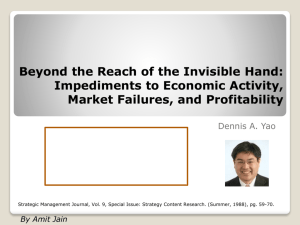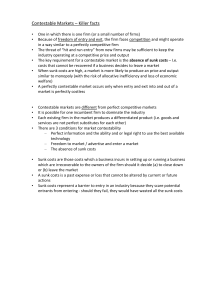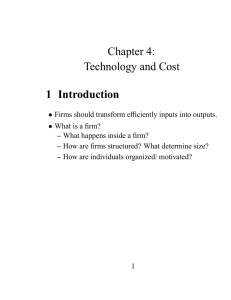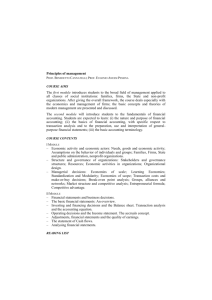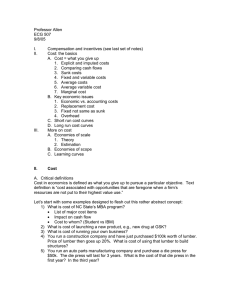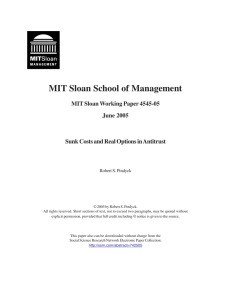Slides
advertisement
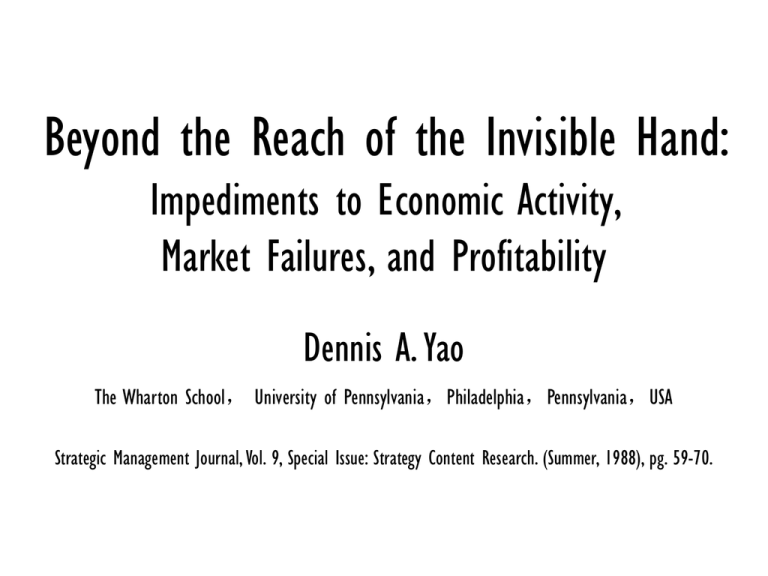
Beyond the Reach of the Invisible Hand: Impediments to Economic Activity, Market Failures, and Profitability Dennis A. Yao The Wharton School, University of Pennsylvania,Philadelphia,Pennsylvania,USA Strategic Management Journal, Vol. 9, Special Issue: Strategy Content Research. (Summer, 1988), pg. 59-70. What is the focus of this Paper ? • In Perfectly Competitive Market : Good Strategy Average Return • In Reality: Firms make excess profits over long time horizon • What might account for this outcome? Main Findings of This Paper “imperfect competition,” is a necessary condition for supra-normal profits Three Causes – Impediments to Economic Activity (IEA) • Production Economies and Sunk Cost • Transaction Costs • Imperfect Information Main Findings of This Paper Production Economies and Sunk Cost • Production Economies – Three Types - Economies of Scale (Natural Monopoly): Production Volume of a product AC Strategy – Information acquisition about future demand Strategy – Development of understanding among incumbents - Economies of Learning: Cumulative Volume MC I have a question here for Learning curve and First mover, P62 - Economies of Scope: Number of Products Strategy – Benefits from Diversification AC Main Findings of This Paper Production Economies and Sunk Cost • Sunk Cost Definition: Costs that cannot be eliminated Contestability Theory: - Concentration alone does not imply non-competitive Pricing - How much does the industry production involve sunk cost ? Strategy for Enter Deference: - The extent to which entry costs are sunk Main Findings of This Paper • Transactions Cost – a basic cause for market incompleteness Sources: The costs of excluding non-buyers from the use of a product or service The costs of communication and information Strategies: Goal Alignment, e.g., vertical integration Free-rider Effects (Not sure whether is it appropriate to put it here) Main Findings of This Paper • Imperfect Information: - Information originates from seller actions or independent information providers - Absence of perfect buyer information above average profit - For goods and services for which quality cannot be physically ascertained before purchase • Strategies: - Information orientated, e.g., reputation, differentiation, warranties. Application of IEA • Production economies and product differentiation: Unprofitable for all new firms Unprofitable for incumbents • Information failure and capital requirement : Imperfect information Restrictions on Capital availability If production economies and sunk cost at low levels, capital requirement not big obstacle • Sunk cost and switching cost: New entrants and firms with low market shares try to reduce switching cost • Imperfect supply-side information and barriers to imitation: Firms can be different in their abilities to produce, and this difference may translate into long-term above average profits Implications for Strategy • Among IEAs, imperfect information seemed particularly important and pervasive • Asymmetry between firms help mitigate the dissipating effect of competition for the excess profit stream offered by market failures • First-mover advantage from good ideas may extend beyond that of temporary profit • For managers, identifying impediments and exploiting the market failures are necessary for profitability Main Point that confused me For the application part, the author does not state the relationship between sunk cost and switching cost very clearly. Future Research • How to deal with free rider effect? • This paper uses different examples from different industries to state a theory. However, there is not much evidence showing what the paper try to say is a theory rather than a phenomenon. Besides, one example to explain a finding is not convincing enough. For future research, maybe we can get more examples for each industry and then see whether the findings in the paper is widely applicable and whether it can be formed into a theory.
